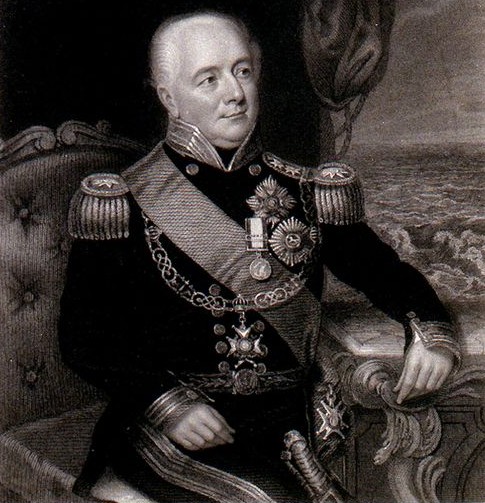- William Hargood
Infobox Person
name = William Hargood

image_size =
caption = Admiral Sir William Hargood
birth_name =
birth_date = 1762
birth_place =England
death_date = death date|1839|12|12|df=y
death_place = Bath,England
death_cause =
resting_place =Bath Abbey
resting_place_coordinates =
residence =
nationality = flagicon|ENG English
other_names =
known_for =
education =
employer =
occupation =Royal Navy Admiral
title =
salary =
networth =
height =
weight =
term =
predecessor =
successor =
party =
boards =
religion =
spouse =
partner =
children =
parents =
relatives =
website =
footnotes =Admiral Sir William Hargood, KCB, GCH, RN (6 May 1762 -12 December 1839 ) was a British naval officer who served with distinction through theAmerican War of Independence , theFrench Revolutionary War and theNapoleonic Wars , during which he gained an unfortunate reputation for bad luck, which seemed to reverse following his courageous actions at thebattle of Trafalgar in command of HMS "Belleisle".Born in 1762 into a poor naval family, the son of a purser, Hargood was able to secure a position as a
midshipman on HMS "Triumph", on which he served from 1775 until the following year, in which time he made a convoy to Newfoundland, and then moved to HMS "Bristol" in which he saw theWest Indies and American Eastern Seaboard, being heavily in involved in the landing atFort Moultrie in 1776. In 1781, Hargood was a lieutenant, [13 January 1780 ] serving in the sloop HMS "Port Royal" when Pensacola fell to the Spanish despite his best efforts to keep it supplied, and in 1782 he was on board HMS "Magnificent" at thebattle of the Saintes . Hargood continued in service in American waters beyond the end of the war, remaining there until he met Captain William Henry (who in 1830 would succeed his brother to become King of England). The two became firm friends, and William took him as his first lieutenant aboard thefrigate HMS "Pegasus" and then HMS "Andromeda", procuring his promotion in 1789 to commander [24 June 1789 ] and getting him the sloop HMS "Swallow", which he commanded for year offIreland before moving to HMS "Hyaena" and the West Indies when he was made aPost Captain . [22 November 1790 ]Captured by the French in 1793 along with his ship, Hargood was exchanged and honourably acquitted and in 1796 given the 50 gun HMS "Leopard", a command which ended in disaster, when he was deposed ashore during the
Spithead mutiny . Moving to HMS "Nassau" and then "HMS Intrepid", Hargood convoyed a fleet ofEast Indiamen toChina , where he remained until thePeace of Amiens in 1803. On his return at the outbreak of war, he was given theship of the line HMS "Belleisle", a good ship captured from the French in thebattle of Groix in 1795. Joining Nelson's fleet in theMediterranean , Hargood participated in the chase across the Atlantic, and his ship was so worn out it required a refit atPlymouth , only rejoining the fleet two weeks before the battle on the21 October .During the battle, "Belleisle" was second in Collingwood's division, following the flagship HMS "Royal Sovereign" into the enemy lines by just fifteen minutes, and when there held his fire until he was able to discharge both sides simultaneously into the "Fougueux" and "Santa Ana". "Belleisle" was engaged continuously during the action, often fighting alone against numerous enemy ships, before finally attaching herself to the "Argonauta", which she boarded and captured, but not before she was herself dismasted. "Belleisle" took almost 25% casualties, with 33 dead and 93 wounded, including Hargood, who had suffered severe bruising during the cannonade. "Belleisle" was lucky to survive the storm, only the constant attentions of the frigate HMS "Naiad" allowing her to be slowly towed back to
Gibraltar .
right|thumb|240px|William Hargood's signatureFollowing the battle, Hargood, who had been unable to get a favourable commission until this point was suddenly inundated with offers, and after some lucrative shore duties, he was made a rear-admiral [
Rear Admiral of the Blue31 July 1810 , of the White1 August 1811 , of the Red12 August 1812 ] and given command of theChannel Islands squadron, which made numerous raids on the French coast and collected a lot ofprize money . In 1811 he married Maria Cocks, and they lived happily together until his death despite their failure to have any children. Following the peace in 1815, Hargood retired from the sea, but retained shore duties, and between this date and his death twenty four years later at his home in Bath, he was made a vice admiral [Vice Admiral of the Blue4 June 1814 , of the White12 August 1819 , of the Red19 July 1821 ] ,Knight Grand Cross of the Order of the Bath , [13 September 1831 ] a Knight Grand Cross of theRoyal Guelphic Order , a full Admiral of the White [10 January 1837 ] and commander-in-chief of the Plymouth Dockyard. Throughout his life he also retained a close and personal friendship with William Henry, even after the latter became King William IV in 1830. He was buried inBath Abbey where his much faded tombstone can still be seen, along with a lengthy epitaph on a mounted wall plaque.Further reading
* "Defiant and Dismasted at Trafalgar: The Life and Times of Admiral Sir William Hargood", Mary McGrigor,
Leo Cooper Ltd, 2004, ISBN 1-84415-034-8
* "The Trafalgar Captains", Colin White and the 1805 Club, Chatham Publishing, London, 2005, ISBN 1-86176-247-XReferences
External links
* [http://www.nelson-society.org.uk/html/william_hargood.htm William Hargood Bio]
* [http://www.nmm.ac.uk/searchbin/searchs.pl?flashy=et1740z&flash=true Animation of the Battle of Trafalgar]
Wikimedia Foundation. 2010.
